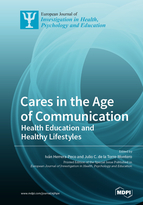Cares in the Age of Communication: Health Education and Healthy Lifestyles
A special issue of European Journal of Investigation in Health, Psychology and Education (ISSN 2254-9625).
Deadline for manuscript submissions: closed (31 December 2020) | Viewed by 48615
Special Issue Editors
Interests: investigation; innovation; education; health; biology; public health
Special Issues, Collections and Topics in MDPI journals
Interests: clinical research and evidence-based practice; clinical trials; wellbeing; palliative care; coping strategies; patient and professional engagement; clinical nursing; nursing education; advanced practice nursing; community cares
Special Issues, Collections and Topics in MDPI journals
Special Issue Information
Dear Colleagues,
Nowadays, the power of social media to share information and connect with others is a reality that has also changed the way people communicate about health information. For instance, sometimes, individuals may not automatically accept the advice of health experts, such as psychologists, nutritionists, nurses or doctors among others, and instead look at what their peers are saying about health issues.
The loss of confidence in health professionals could be dangerous with regard to the diffusion of information about community health and possible alterations of procedures and systems designed to maintain and improve it. So, this situation about the Spreading health education through Social Media requires research and the design of new ways to approach social media users, especially, young people. Initiatives where health professionals must be the main actors and drive the communication initiatives focused on community health with the main goal of recovery the people confidence when they in health issues. Health education has an important challenge in front of all healthcare providers in multiple aspects of caring. Patients and people concerns about self-cares must be addressed and every one of us is an agent for change.
This Special Issue aims to present and foster the research developed by health professionals in relation to the promotion of health and healthy lifestyles through adequate communication strategies.
We accept original research papers, research briefs, and reviews.
Dr. Ivan Herrera-Peco
Dr. Julio C. de la Torre-Montero
Guest Editors
Manuscript Submission Information
Manuscripts should be submitted online at www.mdpi.com by registering and logging in to this website. Once you are registered, click here to go to the submission form. Manuscripts can be submitted until the deadline. All submissions that pass pre-check are peer-reviewed. Accepted papers will be published continuously in the journal (as soon as accepted) and will be listed together on the special issue website. Research articles, review articles as well as short communications are invited. For planned papers, a title and short abstract (about 100 words) can be sent to the Editorial Office for announcement on this website.
Submitted manuscripts should not have been published previously, nor be under consideration for publication elsewhere (except conference proceedings papers). All manuscripts are thoroughly refereed through a single-blind peer-review process. A guide for authors and other relevant information for submission of manuscripts is available on the Instructions for Authors page. European Journal of Investigation in Health, Psychology and Education is an international peer-reviewed open access monthly journal published by MDPI.
Please visit the Instructions for Authors page before submitting a manuscript. The Article Processing Charge (APC) for publication in this open access journal is 1400 CHF (Swiss Francs). Submitted papers should be well formatted and use good English. Authors may use MDPI's English editing service prior to publication or during author revisions.
Keywords
- communication
- health education
- health promotion
- health professions
- lifestyle
- research
- public health
- social media








